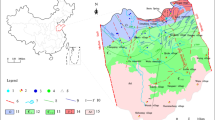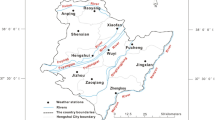Abstract
Understanding spring-flow characteristics in karst areas is very important for efficient utilization of water resources. The time lag of a spring-hydrograph response to rainfall is related to karst hydrogeological properties such as thickness, porosity and hydraulic conductivity. The length of the time lag can be determined based on results of the time-series analysis. However, some approaches, with different identifying indicators, give different lengths of the time lag. In this study, the flow-discharge series of two hillslope springs located in a karst area of southwest China were used to compute lengths of the time lag. The thickness and porosity of the epikarst-zone fractures on the two hillslopes were estimated based on a ground-penetrating radar investigation and field measurement. Based on comparison of lengths of the time lag computed by auto- and cross-correlation analyses, the identifying indicators of the time lag were classified into three types for measuring short, intermediate and long-term responses of the spring hydrograph to rainfall. The study also reveals that the time lag of spring-hydrograph response to rainfall in the thick epikarst zone is much longer than that in the thin epikarst zone.
Résumé
La compréhension des caractéristiques des écoulements au niveau des sources dans les régions karstiques est essentielle pour une utilisation efficace des ressources en eau. Le décalage temporel de l’hydrogramme à la source en réponse aux précipitations est dû aux propriétés hydrogéologiques telles que l’épaisseur, la porosité et la conductivité hydraulique. La longueur du décalage temporel peut être déterminée à partir des résultats des analyses des séries temporelles. Cependant, certaines approches, avec différents indicateurs, donnent des longueurs différentes pour ce décalage. Dans le cadre de cette étude, les chroniques de débits de deux sources de pente situées dans une région karstique du Sud-Ouest de la Chine ont été analysées pour déterminer la durée de ce décalage temporel. L’épaisseur et la porosité des fractures de la zone épikarstique de deux pentes de collines ont été estimées à partir de résultats d’investigation géophysique au radar et de mesures de terrain. A partir des comparaisons des longueurs de décalage obtenues par analyses corrélatoire simple et croisée, les indicateurs identifiés du décalage ont été classés selon trois types de réponses de l’hydrogramme de la source pour des précipitations (courte, intermédiaire et longue). L’étude révèle également que le décalage de l’hydrogramme de la source en réponse aux précipitations dans un épikarst d’épaisseur importante est beaucoup plus long que pour une zone épikarstique peu épaisse.
Resumen
Entender las características del flujo de manantiales en áreas kársticas es muy importante para la utilización eficiente de los recursos hídricos. El tiempo de retardo en la respuesta de un hidrograma de un manantial a la precipitación está relacionado con las propiedades hidrogeológicas kársticas, tales como espesor, porosidad y conductividad hidráulica. La longitud del tiempo de retardo puede ser determinada sobre la base de resultados del análisis de series de tiempo. Sin embargo, algunas aproximaciones, con distintos indicadores de identificación, dan distintas longitudes de tiempos de retardo. En este estudio, se usaron las series de flujo de descarga de dos manantiales de ladera situados en un área kársticas del sudoeste de China para computar las longitudes del tiempo de retardo. El espesor y la porosidad de las fracturas de la zona epikárstica en las dos laderas fueron estimados en base a una investigación de un georadar y mediciones de campo. Basado en la comparación de las longitudes del tiempo de retardo computado por análisis de autocorrelacción y cross correlación, los indicadores que identifican el tiempo de retardo fueron clasificados en tres tipos para la medición de respuestas de corto, mediano y largo plazo del hidrograma del manantial a la precipitación. El estudio también revela que la respuesta del tiempo de retardo de un hidrograma de un manantial a la precipitación en la zona del epikarst espeso es mucho mayor que en la zona de epikarst delgado.
摘要
泉流量特征对喀斯特地区水资源合理利用具有重要的意义。泉流量过程对降雨响应的滞后时间与喀斯特水文地质特征,如厚度、空隙度以及渗透系数等具有密切关系。根据时间序列分析结果可以确定滞后时间。然而,根据不同的判定指标,许多时间序列分析方法可以计算出不同的滞后时间。本研究选取位于中国南方喀斯特地区的两个山坡泉的流量系列计算滞后时间。通过探地雷达勘测和野外调查,对这两个山坡表层岩溶带厚度和裂隙率进行了确定。通过对比自相关和互相关分析计算的滞后时间,将滞后时间判断指标分为三类,分别判断泉流量对降雨的短时、中时和长时响应。同时,本研究结果也显示,较厚表层岩溶带发育的泉流量对降雨响应的滞后时间比较薄表层岩溶带长。
Resumo
Compreender as caraterísticas do fluxo de nascentes em zonas cársicas é muito importante para a utilização eficiente dos recursos hídricos. O tempo de atraso da resposta à precipitação do hidrograma de uma nascente está relacionado com as propriedades hidrogeológicas do carso, tais como a espessura, a porosidade e a condutividade hidráulica. A dimensão do tempo de atraso pode ser determinada com base nos resultados da análise de séries temporais. No entanto, algumas abordagens, com diferentes indicadores de identificação, dão tempos de atraso diferentes. Neste estudo, foram usadas séries de fluxo de descarga de duas nascentes, localizadas a meia encosta numa área cársica do sudoeste da China, para calcular dimensões de tempos de atraso. A espessura e porosidade das fraturas da zona do epicarso nas duas nascentes foram estimadas com base em investigações de radar de penetração no solo e medições de campo. Com base na comparação dos períodos temporais de atraso determinados por meio de análises de auto correlação e de correlação cruzada, os indicadores que identificam o tempo de atraso foram classificados em três tipos, para medição das respostas do hidrograma da nascente à precipitação: curto, intermédio e longo. O estudo revela ainda que o tempo de atraso do hidrograma de nascente em resposta à precipitação na zona do epicarso com maior espessura é muito maior do que na zona de epicarso pouco desenvolvido.













Similar content being viewed by others
References
Al-fares W, Bakalowicza M, Gue’rinc R, Dukhan M (2002) Analysis of the karst aquifer structure of the Lamalou area (He’rault, France) with ground penetrating radar. J Appl Geophys 51(2–4):97–106
Amraoui F, Razack M, Bouchaou L (2003) Turbidity dynamics in karstic systems: example of Ribaa and Bittit springs in the Middle Atlas (Morocco). Hydrol Sci J 48(6):971–984
Benavente J, Pulido-Bosch A, Mangin A (1985) Application of correlation and spectral procedures to the study of the discharge in a karstic system (eastern Spain). In: Karst Water Resources, Proceedings, Ankara-Antalya, Turkey, July 1985, pp 67–75
Beres M, Haeni FP (1991) Application of ground penetrating radar methods in hydrogeologic studies. Ground Water 29(3):375–386
Beres M, Luetscher M, Olivier R (2001) Integration of ground penetrating radar and microgravimetric methods to map shallow caves. J Appl Geophys 46:249–262
Bonacci O (1993) Karst springs hydrographs as indicators of karst aquifers. Hydrol Sci J 38(1):51–62
Box GEP, Jenkins GM, Reinsel GC (1994) Time series analysis: forecasting and control, 3rd edn. Prentice Hall, Englewood Cliffs, NJ
Chen X, Chen C, Hao Q, Zhang Z, Shi P (2008) Simulation of rainfall underground outflow responses of a karstic watershed in southwestern China with an artificial neural network. Water Sci Eng 1(2):1–9
Eisenlohr L, Kiraly L, Bouzelboudjen M, Rossier Y (1997) Numerical simulation as a tool for checking the interpretation of karst spring hydrographs. J Hydrol 193(1–4):306–315
Ford DC, Williams PW (1989) Karst geomorphology and hydrology. Unwin Hyman, London
Ford DC, Williams PW (2007) Karst hydrogeology and geomorphology. Wiley, Chichester, UK, 561 pp
Gand KC, McMahon TA, Finlayson BL (1991) Analysis of periodicity in streamflow and rainfall data by Cowell’s indices. J Hydrol 123:105–118
Jenkins GM, Watts DG (1968) Spectral analysis and its applications. Holden Day, San Francisco, 525 pp
Kovács A, Sauter M (2007) Modelling karst hydrodynamics. In: Goldscheider N, Drew D (eds) Methods in karst hydrogeology, vol 26. International Contribution to Hydrogeology, Heise, Hanover, Germany, pp 201–220
Lambrakis N, Andreou AS, Polydoropoulos P, Georgopoulos E, Bountis T (2000) Non-linear analysis and forecasting of a brackish karstic spring. Water Resour Res 36(4):875–884
Larocque M, Mangin A, Razack M, Banton O (1998) Contribution of correlation and spectral analyses to the regional study of a large karst aquifer (Charente, France). J Hydrol 205:217–231
Lee JY, Lee KK (2000) Use of hydrologic time series data for identification of recharge mechanism in a fractured bedrock aquifer system. J Hydrol 229:190–201
Maloszewski P, Stichler W, Zuber A, Rank D (2002) Identifying the flow systems in a karstic-fissured-porous aquifer, Scheealpe, Austria, by modelling of environmental 18O and 3H isotopes. J Hydrol 256:48–59
Mangin A (1975) Contribution a l’etude hydrodynam ique des aquiferes karstiques [Contribution to the hydrodynamic study of karst aquifers]. Ann Spéliol 29:283–332
Mangin A (1984) Pour une meilleure conaissance des syste’mes hydrologiques a’ partir des analyses corre’latoire et spectrale [For a better understanding of hydrological systems from correlation and spectral analysis]. J Hydrol 67:25–43
McMechan GA, Loucks RG, Zeng X, Mescher P (1998) Ground penetrating radar imaging of a collapsed paleocave system in the Ellenburger dolomite, central Texas. J Appl Geophys 39:1–10
Padilla A, Pulido-Bosch A (1995) Study of hydrographs of karstic aquifers by means of correlation and cross-spectral analysis. J Hydrol 168:73–89
Panagopoulos G, Lambrakis N (2006) The contribution of time series analysis to the study of the hydrodynamic characteristics of the karst systems: application on two typical karst aquifers of Greece (Trifilia, Almyros Crete). J Hydrol 329(3–4):368–376
Perrin J (2003) A conceptual model of flow and transport in a karst aquifer based on spatial and temporal variations of natural tracers. PhD Thesis, University of Neuchâtel, Switzerland
Trček B (2007) How can the epikarst zone influence the karst aquifer hydraulic behaviour? Environ Geol 51(5):761–765
Williams PW (1983) The role of the subcutaneous zone in karst hydrology. J Hydrol 61(1–3):45–67
Williams PW (2008) The role of the epikarst in karst and cave hydrogeology: a review. Int J Speleol 37(1):1–10
Zhang ZC, Chen X, Cheng QB, Peng T, Zhang YF, Ji ZH (2011) Study of hydrogeology of epikarst in karst mountain: a case study of Chenqi catchment (in Chinese). Earth Environ 39(1):19–25
Acknowledgments
This research was supported by the National Natural Scientific Foundation of China Nos. 40930635, 41101018, 51079038, and 51190090. We thank the editor and three anonymous reviewers for their constructive comments on the earlier manuscript, which lead to an improvement of the report.
Author information
Authors and Affiliations
Corresponding author
Rights and permissions
About this article
Cite this article
Zhang, Z., Chen, X., Chen, X. et al. Quantifying time lag of epikarst-spring hydrograph response to rainfall using correlation and spectral analyses. Hydrogeol J 21, 1619–1631 (2013). https://doi.org/10.1007/s10040-013-1041-9
Received:
Accepted:
Published:
Issue Date:
DOI: https://doi.org/10.1007/s10040-013-1041-9




